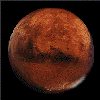 Mars Mars
Mars has greatly intrigued scientists and the general public because of all the planets its environment is most like Earth's. Many scientists believe that Mars once had running water, although surface water is gone today; the planet is very cold with a very thin atmosphere by Earth standards. The planet was explored in flybys by Mariner 4, 6 and 7 in the 1960s and by the orbiting Mariner 9 in 1971 before NASA mounted the ambitious mission, which launched two orbiters and two landers to the planet in 1975. The landers found no chemical evidence of life. landed on the planet on July 4, 1997, delivering a mobile robot rover that explored the immediate vicinity. will create the highest-resolution map of the planets surface. Future pairs of orbiters and landers will be launched in , 2003 and 2005.
Planet Profile
Mass (kg)............................................6.42 x 10^23
Diameter (km)........................................6787
Mean density (kg/m^3) ...............................3940
Escape velocity (m/sec)..............................5000
Average distance from Sun (AU).......................1.524
Rotation period (length of day in Earth days)........1.026
Revolution period (length of year in Earth days).....686.98
Obliquity (tilt of axis in degrees)..................25
Orbit inclination (degrees)..........................1.85
Orbit eccentricity (deviation from circular).........0.093
Maximum surface temperature (K)......................310
Minimum surface temperature (K)......................150
Visual geometric (reflectivity)...............0.15
Highest point on surface.............................Olympus Mons
(about 24 km above surrounding lava plains)
Atmospheric components...............................95% carbon dioxide,
3% nitrogen,
1.6% argon
Surface materials.................................... rock and
altered materials
|
 Mars
Mars